本文共 5740 字,大约阅读时间需要 19 分钟。
转载注明出处:
Unity4.6 后续版本都已经内置了寻路AI了,之前的文章有介绍
然而两年来项目中一直使用的是 A* Pathfinding 这个插件的,所以抽时间来写下这个插件的简单使用。
根据游戏的类型,使用到的插件功能可能会不一样,我这里只介绍最简单的,也是使用的最多的简单寻路。复杂的如跟随、动态,都有对应的例子来学习。
我也一直都没有去看……
转自http://blog.csdn/huutu http://www.thisisgame.com.cn
下面是动态图,借助 A* 插件,编写很少的代码就可以做到寻路。
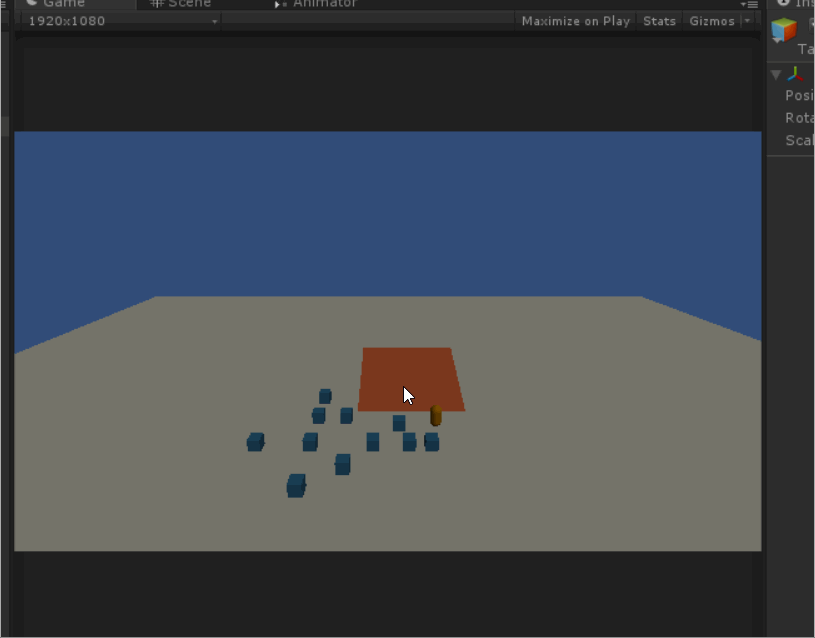
1、创建场景
在场景中添加一些Cube 作为障碍物 Obstacles,添加一个 Capsule 作为Player,然后添加一个Plane 作为地面,再添加一个Plane,作为斜坡。
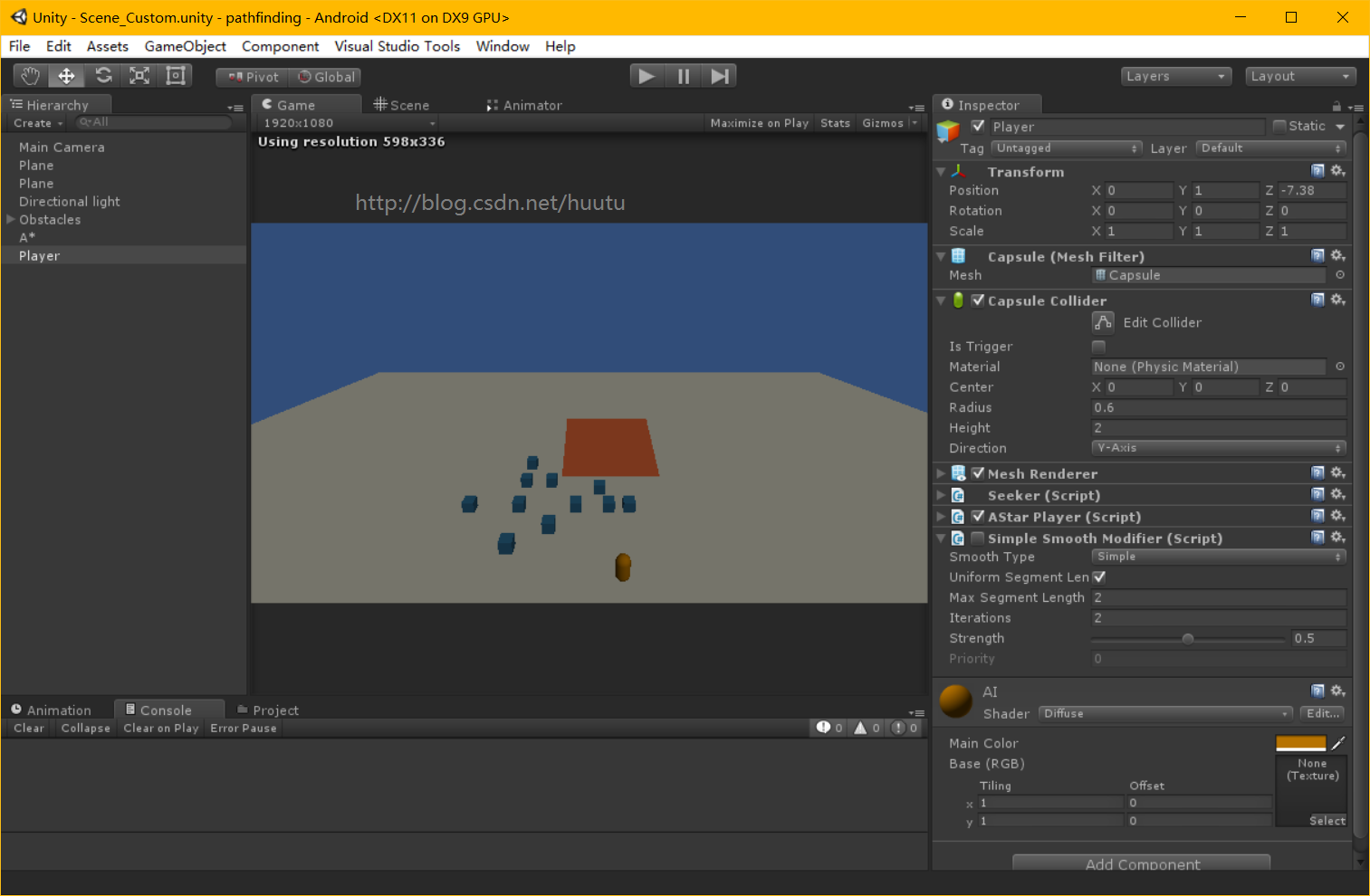
在创建一个GameObject,改名为 A* ,添加A Star Path (Path finder) 组件。

2、编辑场景,指定障碍物
A* 插件中,是根据 Layer 来判断障碍物的,所以我们要把 作为障碍物的 Cubes 都设置到 Obstacle 这一个Layer。
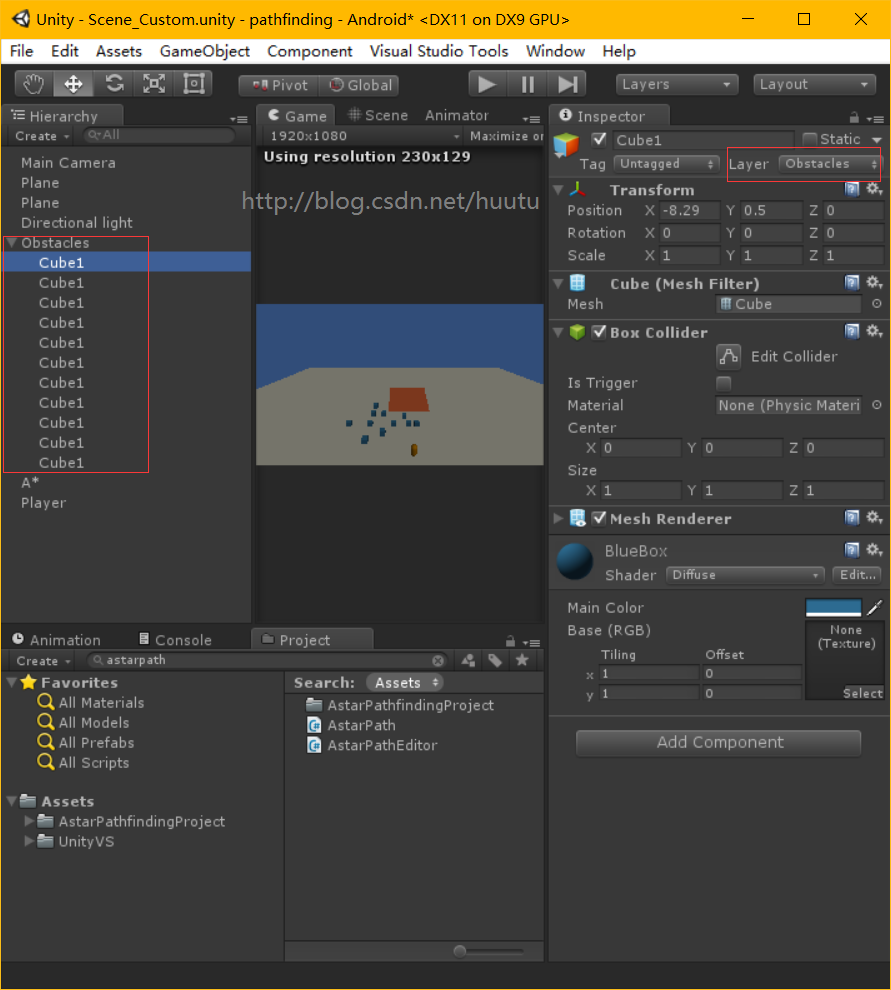
然后给我们的地板,设置Layer 为 Ground ,两块地板都是
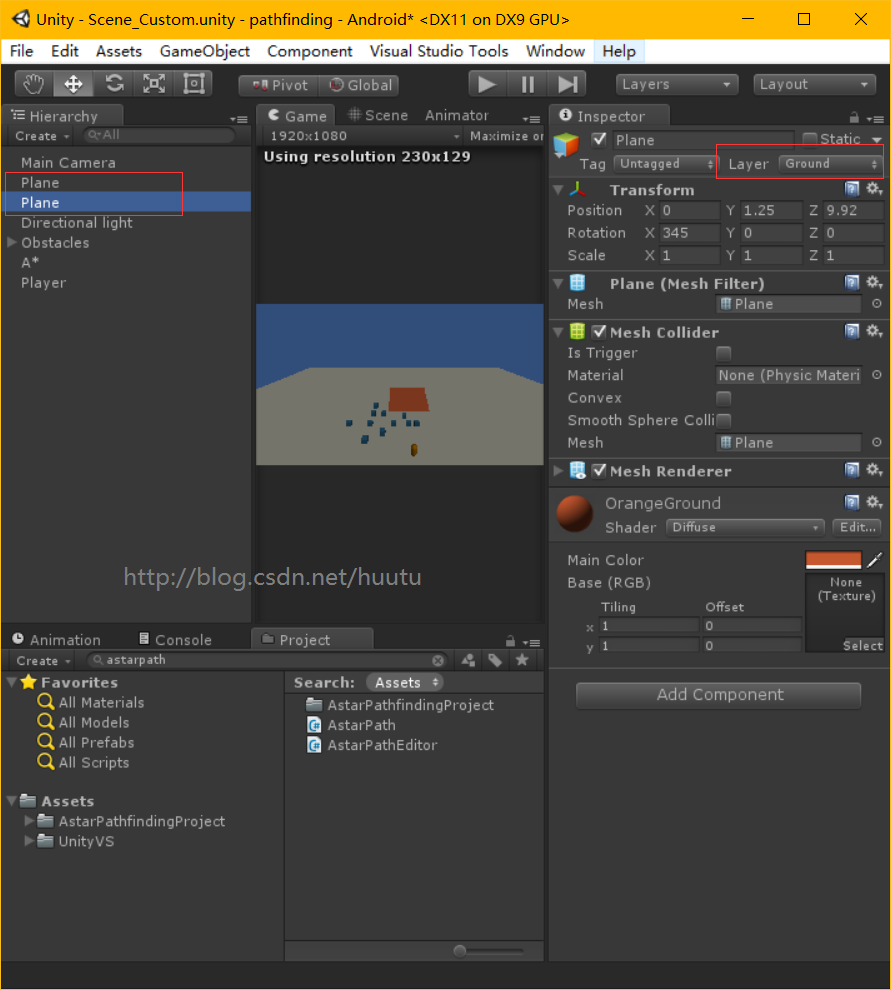
转自http://blog.csdn/huutu http://www.thisisgame.com.cn
3、生成寻路网格
选中 A* ,在Inspector 中,展开 。查看下面的面板。
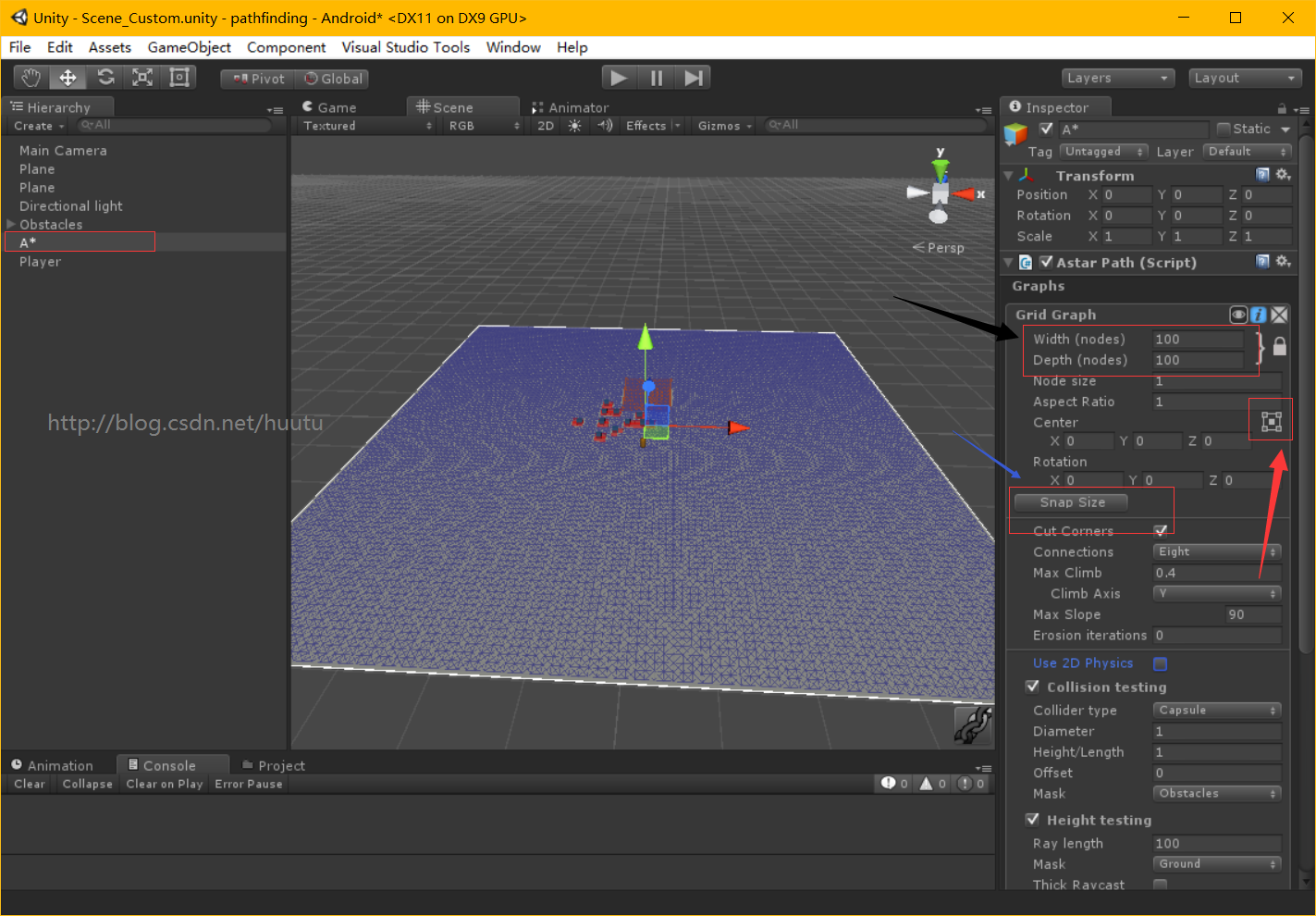
如图中,
黑色箭头所指是宽高,这里的宽高,是指格子的数量。这里用到的就是 A* 的格子寻路。
调整宽高,覆盖整个Plane。
红色箭头所指,是左上、右上、左下、右下、中心 四个点,选中其中一个点,就可以调整这个点的位置。
选中中心,点击蓝色箭头所指的 Snap Size,会根据中心的位置来自动对齐。
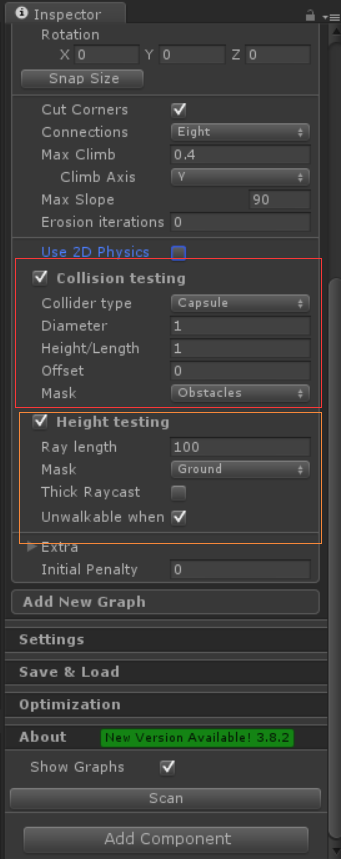
继续设置。
红框中的Collision Testing,是生成 禁止通过 格子的。
因为我们的 Cubes 是障碍物,所以在 Mask 中选择 Cubes 所在的Layer - Obstacles。
黄色框中的Height Testing 是用来 让寻路节点 与 Ground 进行检测的,比如要爬坡的时候就需要检测高度。
设置完成后,点击Scan,就会生成寻路网格。
转自http://blog.csdn.net/huutu http://www.thisisgame.com.cn
4、编写寻路 AI 代码
生成寻路网格之后,我们在代码中就可以使用 A* 来进行寻路了。
首先在 Player 这个 Capsule 上添加Seeker 组件。
然后新建脚本 AStarPlayer.cs 作为测试代码。
在代码中,首先我们从 屏幕发射射线,来定位目标位置。
然后使用 Seeker 来开始生成最短路径。
Seeker生成路径成功后,会把每一个节点的位置保存在 List中。
我们按照顺序读取 List 中的位置,位移Player 到对应的位置,就完成了寻路。
下面是完整代码:
- using UnityEngine;
- using System.Collections;
- using Pathfinding;
-
- public class AStarPlayer : MonoBehaviour
- {
- //目标位置;
- Vector3 targetPosition;
-
- Seeker seeker;
- CharacterController characterController;
-
- //计算出来的路线;
- Path path;
-
- //移动速度;
- float playerMoveSpeed = 10f;
-
- //当前点
- int currentWayPoint = 0;
-
- bool stopMove = true;
-
- //Player中心点;
- float playerCenterY = 1.0f;
-
-
- // Use this for initialization
- void Start ()
- {
- seeker = GetComponent<Seeker>();
-
- playerCenterY = transform.localPosition.y;
- }
-
- //寻路结束;
- public void OnPathComplete(Path p)
- {
- Debug.Log("OnPathComplete error = "+p.error);
-
- if (!p.error)
- {
- currentWayPoint = 0;
- path = p;
- stopMove = false;
- }
-
- for (int index = 0; index < path.vectorPath.Count; index++)
- {
- Debug.Log("path.vectorPath["+index+"]="+path.vectorPath[index]);
- }
- }
-
- // Update is called once per frame
- void Update ()
- {
- if (Input.GetMouseButtonDown(0))
- {
- RaycastHit hit;
- if (!Physics.Raycast(Camera.main.ScreenPointToRay(Input.mousePosition), out hit, 100))
- {
- return;
- }
- if (!hit.transform)
- {
- return;
- }
- targetPosition = hit.point;// new Vector3(hit.point.x, transform.localPosition.y, hit.point.z);
-
- Debug.Log("targetPosition=" + targetPosition);
-
- seeker.StartPath(transform.position, targetPosition,OnPathComplete);
- }
- }
-
- void FixedUpdate()
- {
- if (path == null || stopMove)
- {
- return;
- }
-
- //根据Player当前位置和 下一个寻路点的位置,计算方向;
- Vector3 currentWayPointV = new Vector3(path.vectorPath[currentWayPoint].x, path.vectorPath[currentWayPoint].y + playerCenterY, path.vectorPath[currentWayPoint].z);
- Vector3 dir = (currentWayPointV - transform.position).normalized;
-
- //计算这一帧要朝着 dir方向 移动多少距离;
- dir *= playerMoveSpeed * Time.fixedDeltaTime;
-
- //计算加上这一帧的位移,是不是会超过下一个节点;
- float offset = Vector3.Distance(transform.localPosition, currentWayPointV);
-
- if (offset < 0.1f)
- {
- transform.localPosition = currentWayPointV;
-
- currentWayPoint++;
-
- if (currentWayPoint == path.vectorPath.Count)
- {
- stopMove = true;
-
- currentWayPoint = 0;
- path = null;
- }
- }
- else
- {
- if (dir.magnitude > offset)
- {
- Vector3 tmpV3 = dir * (offset / dir.magnitude);
- dir = tmpV3;
-
- currentWayPoint++;
-
- if (currentWayPoint == path.vectorPath.Count)
- {
- stopMove = true;
-
- currentWayPoint = 0;
- path = null;
- }
- }
- transform.localPosition += dir;
- }
- }
- }
至此简单的寻路了。
在A* 的Example 中,有很多个例子。
最简单的寻路脚本写法是 直接继承 AIPath 。
下面新建一个 脚本 PlayerAI.cs 继承 AIPath 来作为测试
- using UnityEngine;
- using System.Collections;
- using Pathfinding.RVO;
-
- namespace Pathfinding
- {
- [RequireComponent(typeof(Seeker))]
- [RequireComponent(typeof(CharacterController))]
- public class PlayerAI : AIPath
- {
- /** Minimum velocity for moving */
- public float sleepVelocity = 0.4F;
-
- /** Speed relative to velocity with which to play animations */
- public float animationSpeed = 0.2F;
-
- /** Effect which will be instantiated when end of path is reached.
- * \see OnTargetReached */
- public GameObject endOfPathEffect;
-
- public new void Start()
- {
- //Call Start in base script (AIPath)
- base.Start();
- }
-
- /** Point for the last spawn of #endOfPathEffect */
- protected Vector3 lastTarget;
-
- public override void OnTargetReached()
- {
- if (endOfPathEffect != null && Vector3.Distance(tr.position, lastTarget) > 1)
- {
- GameObject.Instantiate(endOfPathEffect, tr.position, tr.rotation);
- lastTarget = tr.position;
- }
- }
-
- public override Vector3 GetFeetPosition()
- {
- return tr.position;
- }
-
- protected new void Update()
- {
-
- if (Input.GetMouseButtonDown(0))
- {
- RaycastHit hit;
- if (!Physics.Raycast(Camera.main.ScreenPointToRay(Input.mousePosition), out hit, 100))
- {
- return;
- }
- if (!hit.transform)
- {
- return;
- }
- target.localPosition = hit.point;
- }
-
- //Get velocity in world-space
- Vector3 velocity;
- if (canMove)
- {
- //Calculate desired velocity
- Vector3 dir = CalculateVelocity(GetFeetPosition());
-
- //Rotate towards targetDirection (filled in by CalculateVelocity)
- RotateTowards(targetDirection);
-
- dir.y = 0;
- if (dir.sqrMagnitude > sleepVelocity * sleepVelocity)
- {
- //If the velocity is large enough, move
- }
- else
- {
- //Otherwise, just stand still (this ensures gravity is applied)
- dir = Vector3.zero;
- }
-
- if (this.rvoController != null)
- {
- rvoController.Move(dir);
- velocity = rvoController.velocity;
- }
- else
- if (navController != null)
- {
- #if FALSE
- navController.SimpleMove (GetFeetPosition(), dir);
- #endif
- velocity = Vector3.zero;
- }
- else if (controller != null)
- {
- controller.SimpleMove(dir);
- velocity = controller.velocity;
- }
- else
- {
- Debug.LogWarning("No NavmeshController or CharacterController attached to GameObject");
- velocity = Vector3.zero;
- }
- }
- else
- {
- velocity = Vector3.zero;
- }
- }
- }
- }
代码量少,但是不如自己写的直观。
两种不同的脚本都可以实现寻路效果。
示例项目打包下载:
- http://pan.baidu.com/s/1hsm6YNi
转载地址:https://linxinfa.blog.csdn.net/article/details/71080462 如侵犯您的版权,请留言回复原文章的地址,我们会给您删除此文章,给您带来不便请您谅解!








